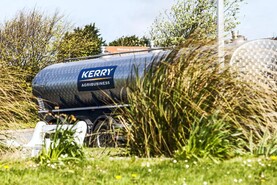A Kerry Group project in collaboration with the United Nations World Food Programme has seen over 200 Burundian dairy farmers receive training in Irish farming practices, half of whom have been women.
Launched in 2020, Project Amata aims to improve food security and nutrition through strengthening the milk value chain in the Gitega province of Burundi.
As well as farmer training, the project has provided funding for the delivery of milk to 3,000 children as part of their everyday school lunch.
Seán McCarthy, services manager at Kerry Agribusiness, visited Burundi in bid to support the creation of a more sustainable milk value chain.
Despite online training with farmers and advisers alike, it wasn't until McCarthy "hit the ground" that he said he really got a feeling for the challenges, infrastructure and resources Burundian farmers have available to them.
"We got to see the full supply chain out there, from the farm right through to the schools where kids were getting milk as part of their lunch.
"The farmers out there really want to learn and are so grateful of the training they are receiving. There was a huge recognition of our presence out there," he said.
Cow nutrition
Some farmers, McCarthy said, are more progressive than others with milk yields ranging from 4l to 20l per day.
"Nutrition is key in all of this, they are starting at a very low base out there. A lot of the cows I saw were local cross-bred cows and the average cow in Burundi is producing 4l per day.
"Before we went there, farmers were talking about importing North American genetics and sexed semen even though they had never used AI.
"From the farms I visited, the best farm had milk yields of 20l and the average is four, so there is definitely room to improve in terms of nutrition first," he said.
Trying to ensure that the forages they have available for cows are of good-quality is the biggest challenge in terms of nutrition, McCarthy said.
"Some farmers were sowing forage themselves, but there was a lot of bartering going on for other components of the feed. They might give someone chickens or eggs in turn for forage for a period of time.
"It's so important that the quality of the feed is consistent and what they're putting in front of the cows is as high a quality as possible."
Breeding
It's the start of a really exciting period in terms of animal breeding in Burundi at the moment, McCarthy said.
In one of the villages McCarthy visited, there was just one stock bull for 80 different farmers.
"AI has really only started to be introduced and we have now six AI technicians trained up through the programme.
"They will deliver the AI to the farmers taking part in the programme and are fundamental to what we're doing," he said.
Milk collection
In Burundi, dairy farmers, who sell their milk to processors, take their milk to the local milk collector first and then this person takes the milk to the processor, Modern Dairy Burundi.
According to McCarthy, 80% of milk in Burundi is sold raw.
"Farmers are walking huge distances to cart the milk to the milk collector, who is usually in the local villages. The milk is then tested and put into an old milk cannister, which holds about 45l and the collector ties it onto his bicycle and takes it to the co-op, which could be three or four hours away. When it gets to the co-op, that's the first time the milk is cooled. From here, it's trucked to the milk processor," he explained.
Other challenges
Mastitis is another issue facing dairy farmers in Burundi, however local advisers have now been trained to use CMT milk kits.
Establishing some form of animal identification or cattle tagging, McCarthy says, would also be vital in getting the foundations of a breeding programme up and running.
Overall, McCarthy said that if and when new genetics are brought into Burundi, they must be suitable to the region’s climate in order to be successful.
The programme will continue into 2023 and will now focus on further training, the establishment of a farmer leader group and educational programmes on the nutritional value of milk and dairy.






 This is a subscriber-only article
This is a subscriber-only article










SHARING OPTIONS: